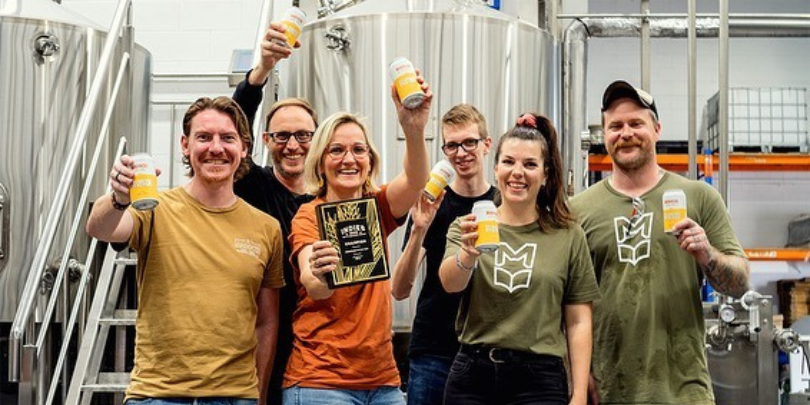
Tax break assists Belgian brewery to Australianise its beers

Madocke Beer Brewing Co. is working towards making its Belgian-style beers with Australian ingredients, through the government’s Research and Development (R&D) Tax Incentive program.
The brewery’s Belgian-Style Blonde, which won Champion European Style Ale at the Indies earlier this month, was made with 80 per cent of Australian malts from Barrett Burston Malting.
“We predominantly do Belgian-style beers because that is our heritage and tradition,” Madocke co-founder and brewery manager Annelies Nijskens told Brews News.
“For that, we did use quite a bit of European malts, yeast, and hops and such, which is quite obvious and normal because those beers have been produced in the European mainland for many centuries already, so the basic ingredients are indeed there to find.
“Australian craft beer breweries do tend to use those ingredients as well and they are getting sourced all over the world. For example, the main yeast depot, even for the Belgian yeast strain, is to be found in America so there is a big ecological footprint towards all the ingredients.
“Under the research and development claim from the ATO, which is a governmental grant and tax deduction, breweries can put a lot of research and development into their products.”
The program, which is administered by Industry Innovation and Science Australia (IISA) and the Australian Taxation Office (ATO), supports businesses to undertake research and development initiatives, by providing a tax offset.
Businesses with turnover of less than $20 million dollars are entitled to a refundable tax offset that is fixed at 18.5 per cent above the company’s corporate tax rate.
Meanwhile, businesses with an aggregated turnover of $20 million dollars or more, are entitled to a non-refundable tax offset of the company’s tax rate, plus an incremental premium based on R&D intensity, which is the company’s total spend identified as eligible R&D expenditure.
For Madocke, undertaking this research was a goal to improve upon freight delays and ingredient sourcing issues, but also to support the Australian agricultural economy.
“We decided that our main goal is to recreate traditional European style beers, but then use purely Australian ingredients, because that would benefit not only the Australian agriculture, [but also] the Australian economy,” Nijskens said.
“And because of all the freight troubles that we had in the past years, because of COVID and everything, freight delays, freight costs, and all that, it was somehow harder for us to get to a few of our ingredients.
“So in our research and development claim that we did with the Australian government, we deliberately put forward that we are going to try to recreate traditional Belgian beers with Australian ingredients and if that is possible.”
The company first started with malts and will move onto hops and yeast in the next steps of the process.
“So first of all, we were going to recreate them by changing the malts from European malts that we are using into Australian malts.
“If that is successful, we will go to the next step which are hops and then lastly, we will see if we can recreate the Belgian beers with the yeast.
“So at the end of that, we will have a completely Australian ingredient-based beer, but then which is still a traditional European style.”
The process
Madocke Beer Brewing’s process with the R&D program began last year, after it made its first claim and began working with two beers.
“One was our Blonde beehive beer, which we used Australian native honey in just to see because there’s not so much research on honey beer,” Annelies Nijskens explained.
“So that was one exercise that we did where we experimented a little bit with honey in beer, that was successful.
“But the main thing was the Blonde beer that we were trying to see how far can we change all European malts with Australian malts, but still have the same quality of a traditional Belgian blonde and so we did a few experiments.
“We won European champion ale with that beer so we nailed it on the head.”
For its Blonde beer, Border Pale Malt from Barrett Burston Malting made up 80 per cent of malts used in the recipe.
While it proved to work well, it took multiple batches to rework the recipe, according to Nijskens.
“We definitely have to look at all the specifications and technical quality and everything of each malt,” she said said.
“So we did quite a bit of research to see which malt would have the most similar parameters towards the European model that we were using.
“And then it is trial and error, because every batch has got its own characteristics and just trying to find out ‘okay, this is the closest if we use it in this way at this temperature in our brewing process’.”
The research had the best results with Border Malt, a product made using Australian barley and malted locally at Barrett Burston’s Pinkenba malthouse. The brewery continues refining its recipes with Australian malts Nijskens explained, and aims to move towards others soon.
“If we can change over more beers with Australian malts, it’s beneficial for Australian agriculture and the economy and the ecological footprint, which is very important these days,” she said.
“Even though we are a Belgian-style brewery, we do not just bring everything in from Europe, we do try to work on Australian ingredients as well.
“And that is a question that we get asked very often from our customers, ‘where do you source all your ingredients from because you’re doing Belgian style beers?’ Does that mean that everything comes from Belgium?’
“We are working to recreate it with Australian ingredients because we found that very important and we can do it because we’ve been crowned Champion European style.”



